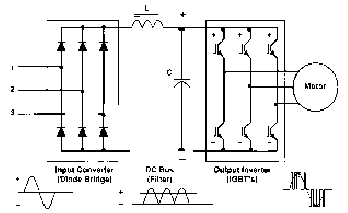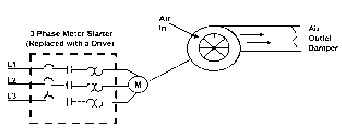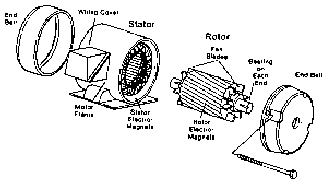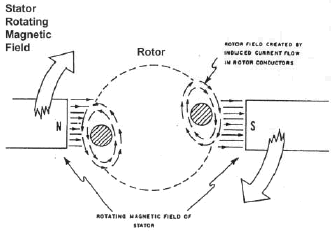A variable-frequency drive (VFD) is a system for controlling the rotational speed of an alternating current (AC) electric motor by controlling the frequency of the electrical power supplied to the motor. A variable frequency drive is a specific type of adjustable-speed drive. Variable-frequency drives are also known as adjustable-frequency drives (AFD), variable-speed drives (VSD), AC drives, micro drives or inverter drives. Since the voltage is varied along with frequency, these are sometimes also called VVVF (variable voltage variable frequency) drives.
Variable-frequency drives are widely used. For example, in ventilations systems for large buildings, variable-frequency motors on fans save energy by allowing the volume of air moved to match the system demand. Variable frequency drives are also used on pumps, conveyor and machine tool drives.
Contents
• 1 Operating principle
o 1.1 Example
• 2 VFD types
• 3 VFD system description
o 3.1 VFD motor
o 3.2 VFD controller
o 3.3 VFD operator interface
• 4 VFD Operation
• 5 Power line harmonics
• 6 Applications considerations
• 7 Available VFD power ratings
• 8 Brushless DC motor drives
Operating principle
The synchronous speed of an AC motor is determined by the frequency of the AC supply and the number of poles in the stator winding, according to the relation:
where
n = Revolutions per minute (rpm)
f = AC power frequency (hertz)
p = Number of poles per phase (an even number)
The constant, 120, is 60 seconds per minute multiplied by 2 poles per pole pair. Sometimes 60 is used as the constant and p is stated as pole pairs rather than poles. By varying the frequency of the voltage applied to the motor, its speed can be changed.
For the number of poles, it is the number of poles per phase. For example a single phase motor with 4 poles will have a 60 Hz synchronous speed of 1800 RPM (see below). However, a three phase motor having 12 poles total will also have a synchronous speed of 1800 RPM, as there will be 4 poles per phase.
Synchronous motors operate at the synchronous speed determined by the above equation. The speed of an induction motor is slightly less than the synchronous speed.
Example
A 4-pole motor that is connected directly to 60 Hz utility (mains) power would have a synchronous speed of 1,800 rpm:
If the motor is an induction motor, the operating speed at full load will be about 1,750 rpm. This rotor rpm is slightly less than synchronous speed since the method of torque production for an induction motor is by the presence of slip (a difference in synchronous speed and actual mechanical speed). Otherwise there would be no induction and therefore no torque produced. On the other hand, if the motor is a synchronous speed, the rotor speed can only match the synchronous speed independent of load.
If the motor is connected to a speed controller that provides power at 50 Hz, the synchronous speed would be 1,500 rpm:
How Drive Changes Motor Speed
Just how does a drive provide the frequency and voltage output necessary to change the speed of a motor? That's what we'll look at next. Fig. 6 shows a basic PWM drive. All PWM drives contain these main parts, with subtle differences in hardware and software components.

Figure 6, Basic PWM Drive Components
Although some drives accept single-phase input power, we'll focus on the 3-phase drive. But to simplify illustrations, the waveforms in the following drive figures show only one phase of input and output.
The input section of the drive is the converter. It contains six diodes, arranged in an electrical bridge. These diodes convert AC power to DC power. The next section-the DC bus section-sees a fixed DC voltage.
The DC Bus section filters and smoothes out the waveform. The diodes actually reconstruct the negative halves of the waveform onto the positive half. In a 460V unit, you'd measure an average DC bus voltage of about 650V to 680V. You can calculate this as line voltage times 1.414. The inductor (L) and the capacitor (C) work together to filter out any AC component of the DC waveform. The smoother the DC waveform, the cleaner the output waveform from the drive.
The DC bus feeds the final section of the drive: the inverter. As the name implies, this section inverts the DC voltage back to AC. But, it does so in a variable voltage and frequency output. How does it do this? That depends on what kind of power devices your drive uses. If you have many SCR (Silicon Controlled Rectifier)-based drives in your facility, see the Sidebar. Bipolar Transistor technology began superceding SCRs in drives in the mid-1970s. In the early 1990s, those gave way to using Insulated Gate Bipolar Transistor (IGBT) technology, which will form the basis for our discussion.
Let's take a brief look at a drive application. In Fig. 1, you can see a simple application with a fixed speed fan using a motor starter. You could replace the 3-phase motor starter with Variable Frequency Drive (VFD) to operate the fan at variable speed. Since you can operate the fan at any speed below its maximum, you can vary airflow by controlling the motor speed instead of the air outlet damper.
Figure 1, Fixed Speed Fan ApplicationA drive can control two main elements of a 3-phase induction motor: speed and torque. To understand how a drive controls these two elements, we will take a short review of AC induction motors. Fig. 2 shows the construction of an induction motor. The two basic parts of the motor, the rotor and stator, work through magnetic interaction. A motor contains pole pairs. These are iron pieces in the stator, wound in a specific pattern to provide a north to south magnetic field.
Figure 2, Basic Induction Motor Construction
Figure 3, Operating Principles of Induction MotorWith one pole pair isolated in a motor, the rotor (shaft) rotates at a specific speed: the base speed. The number of poles and the frequency applied determine this speed (Fig. 4). This formula includes an effect called "slip." Slip is the difference between the rotor speed and the rotating magnetic field in the stator. When a magnetic field passes through the conductors of the rotor, the rotor takes on magnetic fields of its own. These rotor magnetic fields will try to catch up to the rotating fields of the stator. However, it never does -- this difference is slip. Think of slip as the distance between the greyhounds and the hare they are chasing around the track. As long as they don't catch up to the hare, they will continue to revolve around the track. Slip is what allows a motor to turn.
VFD types
All VFDs use their output devices (IGBTs, transistors, thyristors) only as switches, turning them only on or off. Attempting to use a linear device such as transistor in its linear mode would be impractical, since power dissipated in the output devices would be about as much as power delivered to the load.
Drives can be classified as:
• Constant voltage
• Constant current
• Cycloconverter
In a constant voltage converter, the intermediate DC link voltage remains approximately constant during each output cycle. In constant current drives, a large inductor is placed between the input rectifier and the output bridge, so the current delivered is nearly constant. A cycloconverter has no input rectifier or DC link and instead connects each output terminal to the appropriate input phase.
The most common type of packaged VF drive is the constant-voltage type, using pulse width modulation to control both the frequency and effective voltage applied to the motor load.
VFD system description
VFD system
A variable frequency drive system generally consists of an AC motor, a controller and an operator interface.
VFD motor
The motor used in a VFD system is usually a three-phase induction motor. Some types of single-phase motors can be used, but three-phase motors are usually preferred. Various types of synchronous motors offer advantages in some situations, but induction motors are suitable for most purposes and are generally the most economical choice. Motors that are designed for fixed-speed mains voltage operation are often used, but certain enhancements to the standard motor designs offer higher reliability and better VFD performance.VFD controller
Variable frequency drive controllers are solid state electronic power conversion devices. The usual design first converts AC input power to DC intermediate power using a rectifier bridge. The DC intermediate power is then converted to quasi-sinusoidal AC power using an inverter switching circuit. The rectifier is usually a three-phase diode bridge, but controlled rectifier circuits are also used. Since incoming power is converted to DC, many units will accept single-phase as well as three-phase input power (acting as a phase converter as well as a speed controller); however the unit must be derated when using single phase input as only part of the rectifier bridge is carrying the connected load.[
PWM VFD Diagram
As new types of semiconductor switches have been introduced, these have promptly been applied to inverter circuits at all voltage and current ratings for which suitable devices are available. Introduced in the 1980s, the insulated-gate bipolar transistor (IGBT) became the device used in most VFD inverter circuits in the first decade of the 21st century.[
AC motor characteristics require the applied voltage to be proportionally adjusted whenever the frequency is changed in order to deliver the rated torque. For example, if a motor is designed to operate at 460 volts at 60 Hz, the applied voltage must be reduced to 230 volts when the frequency is reduced to 30 Hz. Thus the ratio of volts per hertz must be regulated to a constant value (460/60 = 7.67 V/Hz in this case). For optimum performance, some further voltage adjustment may be necessary especially at low speeds, but constant volts per hertz is the general rule. This ratio can be changed in order to change the torque delivered by the motor.[
In addition to this simple volts per hertz control more advanced control methods such as vector control and direct torque control (DTC) exist. These methods adjust the motor voltage in such a way that the magnetic flux and mechanical torque of the motor can be precisely controlled.
The usual method used to achieve variable motor voltage is pulse-width modulation (PWM). With PWM voltage control, the inverter switches are used to construct a quasi-sinusoidal output waveform by a series of narrow voltage pulses with sinusoidally varying pulse durations. pp82–85.
Operation of the motors above rated name plate speed (base speed) is possible, but is limited to conditions that do not require more power than nameplate rating of the motor. This is sometimes called "field weakening" and, for AC motors, means operating at less than rated volts/hertz and above rated name plate speed. Permanent magnet synchronous motors have quite limited field weakening speed range due to the constant magnet flux linkage. Wound rotor synchronous motors and induction motors have much wider speed range. For example, a 100 hp, 460 V, 60 Hz, 1775 RPM (4 pole) induction motor supplied with 460 V, 75 Hz (6.134 V/Hz), would be limited to 60/75 = 80% torque at 125% speed (2218.75 RPM) = 100% power.[14] At higher speeds the induction motor torque has to be limited further due to the lowering of the breakaway torque of the motor. Thus rated power can be typically produced only up to 130...150 % of the rated name plate speed. Wound rotor synchronous motors can be run even higher speeds. In rolling mill drives often 200...300 % of the base speed is used. Naturally the mechanical strength of the rotor and lifetime of the bearings is also limiting the maximum speed of the motor. It is recommended to consult the motor manufacturer if more than 150 % speed is required by the application.
PWM VFD Output Voltage Waveform
PWM AC variable speed drive
An embedded microprocessor governs the overall operation of the VFD controller. The main microprocessor programming is in firmware that is inaccessible to the VFD user. However, some degree of configuration programming and parameter adjustment is usually provided so that the user can customize the VFD controller to suit specific motor and driven equipment requirements.
VFD operator interface
The operator interface, also commonly known as an Human Machine Interface (HMI), provides a means for an operator to start and stop the motor and adjust the operating speed. Additional operator control functions might include reversing and switching between manual speed adjustment and automatic control from an external process control signal. The operator interface often includes an alphanumeric display and/or indication lights and meters to provide information about the operation of the drive. An operator interface keypad and display unit is often provided on the front of the VFD controller as shown in the photograph above. The keypad display can often be cable-connected and mounted a short distance from the VFD controller. Most are also provided with input and output (I/O) terminals for connecting pushbuttons, switches and other operator interface devices or control signals. A serial communications port is also often available to allow the VFD to be configured, adjusted, monitored and controlled using a computer.[
VFD Operation
When an induction motor is connected to a full voltage supply, it draws several times ( up to about 6 times) its rated current. As the load accelerates, the available torque usually drops a little and then rises to a peak while the current remains very high until the motor approaches full speed.
By contrast, when a VFD starts a motor, it initially applies a low frequency and voltage to the motor. The starting frequency is typically 2 Hz or less. Thus starting at such a low frequency avoids the high inrush current that occurs when a motor is started by simply applying the utility (mains) voltage by turning on a switch. After the start of the VFD, the applied frequency and voltage are increased at a controlled rate or ramped up to accelerate the load without drawing excessive current. This starting method typically allows a motor to develop 150% of its rated torque while the VFD is drawing less than 50% of its rated current from the mains in the low speed range. A VFD can be adjusted to produce a steady 150% starting torque from standstill right up to full speed.[ Note, however, that cooling of the motor is usually not good in the low speed range. Thus running at low speeds even with rated torque for long periods is not possible due to overheating of the motor. If continuous operation with high torque is required in low speeds an external fan is needed. Please consult the manufacturer of the motor and/or the VFD.
In principle, the current on the motor side is in direct proportion of the torque that is generated and the voltage on the motor is in direct proportion of the actual speed, while on the network side, the voltage is constant, thus the current on line side is in direct proportion of the power drawn by the motor, that is U.I or C.N where C is torque and N the speed of the motor (we shall consider losses as well, neglected in this explanation).
(1) n stands for network (grid) and m for motor
(2) C stands for torque [Nm] and U for voltage [V] and I for current [A] and N for speed [rad/s]
We neglect losses for the moment :
Un.In = Um.Im (same power drawn from network and from motor)
Um.Im = Cm.Nm (motot mechanical power = motor electrical power)
Given Un is a constant (network voltage) we conclude : In = Cm.Nm/Un That is "line current (network) is in direct proportion of motor power".
With a VFD, the stopping sequence is just the opposite as the starting sequence. The frequency and voltage applied to the motor are ramped down at a controlled rate. When the frequency approaches zero, the motor is shut off. A small amount of braking torque is available to help decelerate the load a little faster than it would stop if the motor were simply switched off and allowed to coast. Additional braking torque can be obtained by adding a braking circuit (resistor controlled by a transistor) to dissipate the braking energy. With 4-quadrants recifiers (active-front-end), the VFD is able to break the load by appliying a reverse torque and reverting the energy back to the network.
Power line harmonics
While PWM allows for nearly sinusoidal currents to be applied to a motor load, the diode rectifier of the VFD takes roughly square-wave current pulses out of the AC grid, creating harmonic distortion in the power line voltage. When the VFD load size is small and the available utility power is large, the effects of VFD systems slicing small chunks out of AC grid generally go unnoticed. Further, in low voltage networks the harmonics caused by single phase equipment such as computers and TVs are such that they are partially cancelled by three-phase diode bridge harmonics.
However, when either a large number of low-amperage VFDs, or just a few very large-load VFDs are used, they can have a cumulative negative impact on the AC voltages available to other utility customers in the same grid.
When the utility voltage becomes misshapen and distorted the losses in other loads such as normal AC motors are increased. This may in the worst case lead to overheating and shorter operation life. Also substation transformers and compensation capacitors are affected, the latter especially if resonances are aroused by the harmonics.
In order to limit the voltage distortion the owner of the VFDs may be required to install filtering equipment to smooth out the irregular waveform. Alternately, the utility may choose to install filtering equipment of its own at substations affected by the large amount of VFD equipment being used. In high power installations decrease of the harmonics can be obtained by supplying the VSDs from transformers that have different phase shift.[
Further, it is possible to use instead of the diode rectifier a similar transistor circuit that is used to control the motor. This kind of rectifier is called active infeed converter in IEC standards. However, manufacturers call it by several names such as active rectifier, ISU (IGBT Supply Unit) or four quadrant rectifier. With PWM control of the transistors and filter inductors in the supply lines the AC current can be made nearly sinusoidal. Even better attenuation of the harmonics can be obtained by using an LCL (inductor-capacitor-inductor) filter instead of single three-phase filter inductor.
Additional advantage of the active infeed converter over the diode bridge is its ability to feed back the energy from the DC side to the AC grid. Thus no braking resistor is needed and the efficiency of the drive is improved if the drive is frequently required to brake the motor.
Applications considerations
The output voltage of a PWM VFD consists of a train of pulses switched at the carrier frequency. Because of the rapid rise time of these pulses, transmission line effects of the cable between the drive and motor must be considered. Since the transmission-line impedance of the cable and motor are different, pulses tend to reflect back from the motor terminals into the cable. If the cable is long enough, the resulting voltages can produce up to twice the rated line voltage, putting high stress on the cable and motor winding and eventual insulation failure. Because of the standard ratings of cables and windings, this phenomenon is of little concern for modern 230 V motors, may be a consideration for long runs and 480 V motors, and frequently a concern for 600 V motors. At 460 V, the maximum recommended cable distances between VFDs and motors can vary by a factor of 2.5:1. The longer cables distances are allowed at the lower Carrier Switching Frequencies (CSF) of 2.5 kHz. The lower CSF can produce audible noise at the motors. For applications requiring long motor cables VSD manufacturers usually offer du/dt filters that decrease the steepness of the pulses. For very long cables or old motors with insufficient winding insulation more efficient sinus filter is recommended.
Further, the rapid rise time of the pulses may cause trouble with the motor bearings. The stray capacitance of the windings provide paths for high frequency currents that close through the bearings. If the voltage between the shaft and the shield of the motor exceeds few volts the stored charge is discharged as a small spark. Repeated sparking causes erosion in the bearing surface that can be seen as fluting pattern. In order to prevent sparking the motor cable should provide a low impedance return path from the motor frame back to the inverter. Thus it is essential to use a cable designed to be used with VSDs.
In big motors a slip ring with brush can be used to provide a bypass path for the bearing currents. Alternatively isolated bearings can be used.
The 2.5 kHz and 5 kHz CSFs cause less motor bearing problems than caused by CSFs at 20 kHz. Shorter cables are recommended at the higher CSF of 20 kHz. The minimum CSF for synchronize tracking of multiple conveyors is 8 kHz.
The high frequency current ripple in the motor cables may also cause interference with other cabling in the building. This is another reason to use a motor cable designed for VSDs that has a symmetrical three-phase structure and good shielding. Further, it is highly recommended to route the motor cables as far away from signal cables as possible.
Available VFD power ratings
Variable frequency drives are available with voltage and current ratings to match the majority of 3-phase motors that are manufactured for operation from utility (mains) power. VFD controllers designed to operate at 110 V to 690 V are often classified as low voltage units. Low voltage units are typically designed for use with motors rated to deliver 0.2 kW or 1/4 horsepower (hp) up to several megawatts. For example, the largest ABB ACS800 single drives are rated for 5.6 MW[22] . Medium voltage VFD controllers are designed to operate at 2,400/4,162 V (60 Hz), 3,000 V (50 Hz) or up to 10 kV. In some applications a step up transformer is placed between a low voltage drive and a medium voltage load. Medium voltage units are typically designed for use with motors rated to deliver 375 kW or 500 hp and above. Medium voltage drives rated above 7 kV and 5,000 or 10,000 hp should probably be considered to be one-of-a-kind (one-off) designs
Medium voltage drives are generally rated amongst the following voltages : 2,3 KV - 3,3 Kv - 4 Kv - 6 Kv - 11 Kv
The in-between voltages are generally possible as well. The power of MV drives is generally in the range of 0,3 to 100 MW however involving a range a several different type of drives with different technologies.
Brushless DC motor drives
Much of the same logic contained in large, powerful VFDs is also embedded in small brushless DC motors such as those commonly used in computer fans. In this case, the chopper usually converts a low DC voltage (such as 12 volts) to the three-phase current used to drive the electromagnets that turn the permanent magnet rotor.



Great Post !! This is the best information I ever read on this blog will share the information. A variable frequency drive (VFD) is a control device that converts alternating current (AC) electric power to the desired fixed or variable frequency of AC power.
ReplyDelete